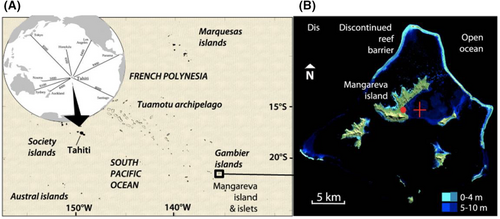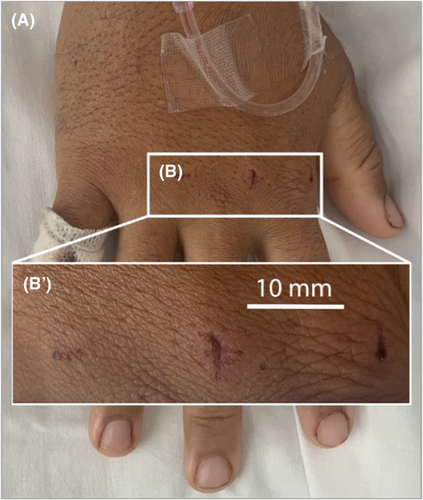First tiger shark Galeocerdo cuvier bite in 75 years in French Polynesia (Eastern Central Pacific)
Abstract
We analyzed a tiger shark (estimated 2.8 m total length) bite on a snorkeler. The removal of the terminal part of the leg suggests a predatory motivation for the bite. This is the first documented bite by a tiger shark in French Polynesia waters for the past 75 years.
1 INTRODUCTION
Despite a persistent public perception that shark bites result primarily from feeding attempts, a study published in 19741 noted that “a significant fraction of shark ‘attacks’ on man may well be the result of aggressive behavior directed at the victims in an attitude of fighting rather than feeding.” This distinction is important because most nonpredatory bites are relatively superficial, whereas those resulting from feeding attempts typically result in massive tissue loss and hemorrhaging.2 Although some nonpredatory bites may ultimately prove lethal,3 fatalities are much more like to result from the massive tissue damage associated with predatory bites.4
French Polynesia consists of 118 islands spread over an area of 4.5 million km2 in the central-eastern Pacific with an economy based largely on tourism (especially marine ecotourism). Underwater shark watching is a major activity, generating millions of dollars annually in some islands such as Moorea.5 Nevertheless, the presence of shark species that are potentially dangerous to humans creates risk management challenges for this type of ecotourism.6 For example, tiger sharks Galeocerdo cuvier, which were the flagship species observed at the Vallée Blanche dive site in Tahiti between 2011 and 2017,7 bite humans more often than any other shark species except the white shark Carcharias carcharodon. However, tiger sharks have never been implicated in a bite on humans in French Polynesia since written records began in 1940 (E. E. G. Clua, personal observation).
Here we analyze a nonfatal tiger shark bite on a male snorkeler in French Polynesia to determine the likely motivation for the incident. We discuss the shark risk management implications for a country, which is highly economically dependent on marine ecotourism.
2 CASE HISTORY
2.1 Data collection
In the course of the investigation, the first author (EEGC)—as an expert at the Court of Papeete—was given access to medical photos of the victim's wounds and interviewed the victim at the hospital 2 days after the incident. Additional relevant information from the remote location of the incident was collected by one of the co-authors (OJ).
2.2 Incident background
On December 22, 2021, two Polynesian pearl-farm workers visited a site in the Rikitea lagoon in order to install larval collectors. After arriving on site and mooring to a buoy (Figure 1), one worker entered the water wearing a full wetsuit without gloves, 70 cm-long fins (CRESSI brand—Gara model), and a mask and snorkel. Once in the water and while still close to the boat, he visually scanned a 360° area from the surface without noticing anything abnormal. After swimming 20 m away from the boat towards the work site, he noticed a “large” tiger shark approaching him tangentially from a depth of about 10 m. Accustomed to encountering, and being ignored by, large tiger sharks 3–4 times a year, he looked away from the animal. A few seconds later, he instinctively turned around to find the shark near the surface lunging towards him at chest level, with its mouth open. He pushed on the shark's snout to deflect it resulting in it grabbing his right leg, fin first. He then started to scream at his colleague on the boat. The shark then closed its jaws at mid-shin height and shook its head several times while the diver tried to reach the shark's eyes with both hands. During this attempt, his right hand involuntarily entered the shark's mouth, while he managed, with his left hand, to push three digits (including the thumb) into the shark's right eye. As he pushed his fingers in, he felt and heard his shin crack under the shark's teeth, and the shark instantly released him and moved away, swallowing the diver's foot. According to the victim, the contact with the shark lasted <30 s. When the boat arrived at the scene few seconds after, the diver was able to get back on the boat with the help of the pilot. They installed rope tourniquets above and below his knee before transiting to the pier near the medical center where the victim received medical attention within approximately 15 min (Figure 1). When questioned by the emergency doctor, the victim described the shark's behavior as “curious and want-to-play-like.”

2.3 Shark species and size assessment
During treatment, the victim's wounds were photographed along with a metric scale bar. The general and specific characteristics of the bite wounds were analyzed and compared with anatomical data compiled for each species of large shark capable of inflicting such wounds on a human.4 We used the characteristic tooth marks left by unfinished and superficial bites to assess the size of the animal. The centre of each tooth mark was used to measure the interdental distance (IDD) between two tooth tips; these measurements were averaged and we used a published total length (TL) to IDD regression algorithm to determine the size of the animal.8
2.4 Fatal shark bites in French Polynesia
Since 2005, CRIOBE has maintained a shark bite incident database for French Polynesia. Data characterizing the victim's profile, their ocean activity, and the circumstances of the incident are collected from press (written and televised) reports and the register of medical evacuations from remote islands compiled by the Central Hospital of the capital Tahiti. This information is further supplemented with onsite interviews by the first author aimed at documenting the history of shark bites at islands throughout French Polynesia, as well as by the existing literature on shark bites in this region.9-13
3 DIFFERENTIAL DIAGNOSIS
3.1 Description of the wounds and assessment of the shark size
The main wound severed the right leg at the level of the lower third of the tibia (Figure 2A,B). Characteristic shark tooth marks on the lateral-internal portion of this circular wound (Figure 2C) allowed an average interdental distance (IDD) of 19 mm to be estimated (Figure 2D,D′). Based on this average IDD, shark size was estimated to be 2862 mm in total length (TL). The victim's right hand also had three superficial puncture wounds consistent with contiguous tooth marks (Figure 3), which yielded a mean IDD of 18 mm, consistent with the assessment from the main wound. The culprit size (2.8 m TL) is also consistent with the testimony of a local fisherman interviewed by one of the co-authors (OJ) regarding another incident on 18 December about 1 km from the bite site where a young snorkeler was pursued by a tiger shark as he rushed to board the fisherman's boat to escape the animal, which bit the boat instead.


3.2 Human fatalities and shark bite motivations
Analysis of 125 shark bite cases that occurred in French Polynesia between 1940 and 2022 revealed patterns consistent with those observed in a previous study of 54 shark bites occurring between 1979 and 2001 in this region.11 Most shark bites were nonfatal and involved either scuba divers feeding sharks or spearfishers, but four bites resulted in the death of the victim (Table 1). Two fatalities resulted from self-defensive bites when spearfishers wounded sharks.9, 13 Another fatality was attributable to dominance/territoriality behavior by gray reef sharks that attacked a turtle fisherman who probably inadvertently entered their idiosphere10. The remaining fatality resulted from a deep bite to the thigh of a fisherman who fell overboard and was attacked by an oceanic whitetip shark9 (Table 1).
| Year | Gender | Age | Island | Species involved | Activity | Death cause | Bite motivation | Source |
|---|---|---|---|---|---|---|---|---|
| 1942 | Male | U | Arutua |
Gray reef shark Carcharhinus amblyrhynchos |
Spear-fishing | Bite to the neck with the section of the carotid by a shark previously wounded by a fisherman | Self-defense | Lagraulet et al.9 |
| 1962 | Male | 42 | Puka-Puka |
Gray reef shark Carcharhinus amblyrhynchos |
Turtle-fishing | Multiple bites by two sharks on the swimmer at the surface with heavy exsanguination | Dominance/territoriality | Bagnis10 |
| 1969 | Male | 35 | Moorea |
Oceanic whitetip shark Carcharhinus longimanus |
Fishing from a boat | Massive bite on the thigh of the victim who fell off the boat into a feeding frenzy | Indirect predation | Lagraulet et al.9 |
| 1977 | Male | U | Tepoto Nord |
Sicklefin lemon shark Negaprion acutidens |
Spear-fishing | Multiple bites with heavy exsanguination by a shark previously wounded by a fisherman | Self-defense | Clua and Haguenauer13 |
- Note: The 1969 case study is the only one that could be classified as “predation” because the victim inadvertently became part of a feeding frenzy involving oceanic whitetip sharks (a highly traumatogenic species). The feeding purpose of the bite is highly probable, but the predation is qualified here as “indirect” in that it is very difficult to distinguish a deliberate choice by the shark to consider humans as potential prey from a reflex bite exacerbated by competition with other sharks for food.
- Abbreviation: U, unknown.
4 DISCUSSION
The tiger shark G. cuvier is ubiquitous in French Polynesia, where no <55 different individuals have been observed in under 5 years at the Vallée Blanche site off Tahiti alone.7 It is an integral part of Polynesian mythology, locally referred to as Ma'o Tore-Tore in the Society island and the Austral archipelago, Mago Tagatukao in the Tuamotu archipelago, and Mako Ka'eva'eva in the Marquesas (E. E. G. Clua, personal observation). Just as the Hawaiian term “niuhi” meaning “man-eater” refers to both white and tiger sharks,14 the term “parata” in French Polynesia refers to both oceanic whitetip sharks (OWT) Carcharhinus longimanus, and tiger sharks.16 Both terms primarily represent the concept of “a large shark capable of devouring a man” more than any particular species of shark, but both recognize the ability of tiger sharks to prey on humans. It is therefore surprising that, until this recent incident off Rikitea, no tiger shark bites on humans had been documented in French Polynesia since records began in 1940.
The predatory motivation for the Rikitea bite is clearly indicated by (i) the attempted surprise attack, (ii) the lack of preceding agonistic behavior, and (iii) the removal and consumption of the lower leg. The victim survived primarily because of the close presence of the boat and a companion, and the effective first-aid treatment (tourniquets) applied by his companion. The size estimate of around 3 m is consistent with the victim's description of the shark as having a “juvenile” appearance, probably referring to the slender morphology typical of sexually immature tiger sharks (tiger sharks in the Pacific reach sexual maturity at lengths of 2.9–3.4 m TL17). Only two previous predatory shark bites have been documented during recorded history in French Polynesia. Both of these cases involved the highly traumatogenic OWT in waters off Moorea, with one fatal incident in 1970 involving a fisherman who fell from a boat in the middle of a feeding frenzy (Table 1) and the other nonfatal bite in 2019 on a whale-watching female snorkeler.18 With only two predatory and four fatal bites in over 70 years (Table 1), the likelihood of a shark bite fatality remains extremely low in French Polynesia, and this is the first time in recorded history that a tiger shark has been identified as the perpetrator of a bite on humans in this region (although there is still the chance that tiger sharks were involved in previous bites without being identified). This is particularly surprising given that tiger sharks are a chronic danger to humans in the Hawaiian Islands,19 which have many similar habitat and anthropogenic use characteristics (e.g., practice of numerous water sports, including surfing) to French Polynesia. This stark contrast between Hawaii and French Polynesia, both regions where tiger sharks are common, shows that shark abundance20 and external environmental factors alone21-23 cannot fully explain observed patterns of shark bites. In recent years there has been a growing recognition that sharks have individual personalities (e.g., some individuals are inherently bolder and more prone to risk-taking than others).24 Genetic mediation of these behavioral traits25 could potentially explain the differences in the frequencies of shark bites between Hawaii and French Polynesia. Simply stated, the tiger sharks in Hawaii may be genetically more inclined than those in French Polynesia to bite humans. However, the recent incident off Rikitea shows that this behavioral trait also exists in the French Polynesian tiger shark population and the fact that it was preceded by an aggressive encounter with a similar tiger shark in a nearby location 4 days before the bite (see 3-1 section) also supports it.
5 CONCLUSION
This incident clearly highlights the importance of prompt and effective first-aid treatment in the successful management of serious shark bites. The sudden emergence of previously undocumented aggressive behavior by a tiger shark towards humans in French Polynesia demonstrates that countries where tiger sharks occur26 should conduct risk assessments of in-water activities that may bring humans into contact with this species. Future environmentally responsible shark risk management could combine individual genetic profiling with photoidentification,27 and leverage existing shark photo-ID databases.7
AUTHOR CONTRIBUTIONS
Eric E. G. Clua: Conceptualization; data curation; formal analysis; investigation; methodology; project administration; supervision; writing – original draft. Michel Bègue: Conceptualization; data curation; writing – review and editing. Olivier Jam: Data curation; resources; writing – review and editing. Raphaël Lambillon: Data curation; resources; validation; writing – review and editing. Carl G. Meyer: Conceptualization; formal analysis; methodology; supervision; writing – review and editing.
ACKNOWLEDGMENTS
We wish to thank the SAMU department of the Centre Hospitalier de Polynésie Française for its support to access the information.
FUNDING INFORMATION
This study benefited from the financial support of the LABEX CORAIL through the “invited scientist” mechanism awarded to Dr C. G. Meyer.
CONFLICT OF INTEREST
All authors declare they have no conflict of interest.
CONSENT
Written informed consent was obtained from the patient to publish this report in accordance with the journal's patient consent policy.
Open Research
DATA AVAILABILITY STATEMENT
Data available on request due to privacy/ethical restrictions.




